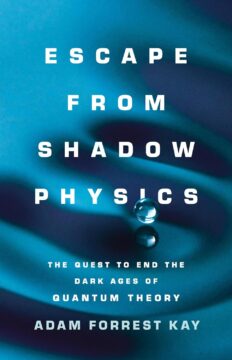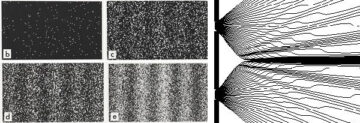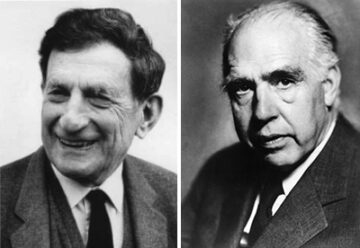by David Kordahl
 There’s an old story, popularized by the mathematician Augustus De Morgan (1806-1871) in A Budget of Paradoxes, about a visit of Denis Diderot to the court of Catherine the Great. In the story, the Empress’s circle had heard enough of Diderot’s atheism, and came up with a plan to shut him up. De Morgan writes,
There’s an old story, popularized by the mathematician Augustus De Morgan (1806-1871) in A Budget of Paradoxes, about a visit of Denis Diderot to the court of Catherine the Great. In the story, the Empress’s circle had heard enough of Diderot’s atheism, and came up with a plan to shut him up. De Morgan writes,
Diderot was informed that a learned mathematician was in possession of an algebraical demonstration of the existence of God, and would give it him before all the Court, if he desired to hear it. Diderot gladly consented: though the name of the mathematician is not given, it was Euler. He advanced towards Diderot, and said gravely, and in a tone of perfect conviction: Monsieur, (a + bn) / n = x, donc Dieu existe; répondez! Diderot, to whom algebra was Hebrew, was embarrassed and disconcerted; while peals of laughter rose on all sides. He asked permission to return to France at once, which was granted.
De Morgan concedes that the story may not be true, yet even at face value, it’s a puzzling anecdote. De Morgan tells us that “Euler was a believer in God, downright and straightforward.” It’s obvious that an algebraic expression has no bearing on God’s existence. In the story, Diderot misses that point (the historical Diderot was not, in fact, so ignorant), but it leads the modern reader to wonder…so what? Diderot may or may not have been an overly dogmatic atheist, but should a “downright and straightforward” believer really defend his beliefs with bullshit?
The modern reader might then ask a followup question. What questionable claims today have been made harder to dismiss by cloaking them in math?
A few possibilities from economics and psychology come to mind, but this column will discuss a new book that advances the charge against quantum physics. Escape from Shadow Physics: The Quest to End the Dark Ages of Quantum Theory, by Adam Forrest Kay, forwards some complaints that readers of popular physics may find find a little familiar (cf. Sabine Hossenfelder’s Lost in Math, or Adam Becker’s What Is Real?), but Kay introduces enough historical and philosophical breadth to make his version my new favorite of the bunch, if with some reservations about its conclusions.
When I ordered Escape from Shadow Physics, I’ll admit I thought I knew exactly what I was about to review. The author description boasts that Kay has doctorates in both literature and math, and is now a math postdoc at MIT. I figured that Kay was probably a follower of David Bohm (1917-1992), who argued for a particle and wave interpretation of quantum phenomena, an interpretation that—for reasons we’ll get to below—has always smelled funny to most physicists.
But Kay is not a dogmatic Bohmian, and his interest in quantum questions comes from a sort of second coming of the “particle + guiding wave” scheme. Kay is interested in “hydrodynamic quantum analogs” (HQAs), systems that are big enough to be observed with ordinary cameras, but which model effects that are usually attributed to quantum physics. These were discovered about two decades ago, and involve little oil droplets that persistently bounce on the surface of an externally vibrated bath.
If you haven’t seen them before, you may want to take a look at the video by Derek Muller (a.k.a., “Veritasium”), embedded below.
Hydrodynamic quantum analogs arise from the ordinary wave behavior of ordinary fluids, at the temperatures and pressures that we experience every day. The quantum analogy arises because, when containers of such fluids are vibrated in particular ways, they can sustain droplets that bounce for indefinitely long periods on their surfaces without recombining with the bath—i.e., they show us particles (the droplets) whose behavior is directed by waves (the fluid surface).
Which is, of course, quite suggestive, and sounds more than a little like David Bohm’s version of quantum theory. But I had been aware that there were people who didn’t think that HQAs were living up to their initial promise. For instance, I remembered this headline from Quanta from a few years ago:
Famous Experiment Dooms Alternative to Quantum Weirdness.
What was that all about? Kay talks about it in Chapter 24 (“Diffracting Droplets”), and feels that the Quanta article misrepresented the case.
Consider the standard version of the “double slit experiment” – the famous experiment to which the headline above refers. Two thin slits are carved into a screen, and quantum particles (photons, electrons, whatever) are then sent toward it. When they are measured at a second surface downstream, each particle shows up a seemingly random place. But when many such particles are measured, their statistics resemble what one would observe from interacting waves.
Richard Feynman famously commented that this phenomenon was “impossible, absolutely impossible, to explain in any classical way,” and many have parroted similar sentiments. Yet Bohm showed that Feynman’s claim wasn’t really right. If one posits that particles are sprinkled on the wave according to the probability distribution implied by its density in space, Bohm’s “guidance equation” describes the particles’ motion, and the particles follow sharply defined paths that reproduce exactly the interference patterns that are observed. Second-generation Bohmians then showed that the initial conditions weren’t even that important – if particles follow the guidance equation, the dynamics should take care of it.
So what’s the problem? Well, the HQA version of the double-slit experiment doesn’t work. Or, rather, it doesn’t work in quite the same way that the quantum version of it works, since, after all, the analogy is not exact. Droplets bouncing on top of a vibrating fluid bath are not literally quantum. But Kay insists that this is no reason to give up on the analogy prematurely. “If a baby failed to walk at the normal time, would anyone just throw up their hands and say the baby is failed?”

If David Bohm and the HQA researchers are the heroes of this story, who are the villains? As in Adam Becker’s What Is Real?, Adam Kay’s Escape from Shadow Physics places much of the blame for contemporary quantum muddles on the original quantum godfather, Neils Bohr (1885-1962), and the defenders of the “Copenhagen interpretation” who grew up in his shadow. (Bohr was Danish.)
Kay includes quotes from scientists who frame Bohr as a moral leader rather than just a scientist. Bohr was more likely to be compared by proteges to Socrates or Jesus Christ than Newton or James Clerk Maxwell. Under the Copenhagen interpretation, statistical outcomes were fundamental, and it was fruitless to imagine things happening under the hood that might cause such statistics. The idea that sharp outcomes and statistical predictions should continue to exist in constant tension was enshrined as the principle of “complimentarity,” which, as Ash Jogalekar wrote in a column for this site, “provided a way to reconcile the paradoxes that seemed to bedevil quantum theory’s interpretation of reality.”
N. David Mermin memorably described the Copenhagen interpretation as the “shut up and calculate” interpretation of quantum mechanics, since it posits that we shouldn’t worry about what’s going on between measurements. The standard defender against this point of view, in the usual quantum lore, is none other than Albert Einstein (1875-1959), whose pithy question of whether the moon only exists when one looks at it has come to stand for the idea that something must be happening below the statistics, even if we don’t know exactly what.
Though it does recount the usual back-and-forth of the Bohr-Einstein debates, Escape from Shadow Physics also does something more interesting. Near the book’s beginning, Kay spends over fifty pages on the history of thermal physics, with the aim of teasing out the parallels between 19th-century thermodynamics and 20th-century quantum mechanics, suggesting that the sorts of models that ultimately clarified thermodynamics have yet to arrive for the quantum.
In the early days of thermodynamics, some thought that heat was composed of an exceedingly fine substance they called “caloric,” but no one seemed to be able to capture the stuff on its own. A big breakthrough came with the work of Jean-Baptiste Fourier, who came up with an equation that was able to accurately describe how heat spread through solid bodies without worrying too much about what, exactly, heat was. The philosopher Auguste Comte thought this was exactly as things should be, and praised Fourier as an example of the sort of empiricism that he endorsed—an empiricism he called “positivism,” which explicitly renounced the search for hidden causes, instead sticking close to observations.
Was Comte right? The history of science seems to imply he wasn’t, since thermal effects would later be explained by just the sorts of hidden causes—the motions of invisible atoms—that Comte denounced. (Though, even there, there’s controversy, as I discussed in an earlier column here at 3 Quarks Daily.)
Kay likens the situation of pre-atomic thermodynamics to that of contemporary quantum mechanics. Just as Fourier’s diffusion equation was able to capture important phenomena without addressing their underlying cause, might the Schrödinger equation, that fundamental equation of quantum theory, be highly effective at describing physical processes without itself being fundamental? This is the heart of the book’s argument. In every other case we know about, statistical outcomes are not an end in themselves, but arise from lower-level events. Why should probabilities in quantum mechanics be an exception?

The idea that “hidden variables” could under-grid quantum probabilities was anathema to early theorists, who, much like De Morgan’s Euler, gestured toward a faulty proof to insist upon their beliefs. To be fair, they didn’t know that the proof was faulty—it had been written by John von Neumann, an Euler-grade genius, and geniuses are sometimes right about things that confuse the rest of us. But once Bohm produced an explicit hidden-variable theory, one that reproduced quantum phenomena in all its details, von Neumann’s argument lost its sway.
Today, people who wish to argue about the metaphysical consequences of quantum mechanics tend to point toward Bell’s theorem and its assorted generalizations. (Jochen Szangolies, a columnist for 3 Quarks Daily, has written extensively about this, and is the local expert on such matters.) Kay thinks this all has been vastly oversold, and discusses the possibility that various quantum measurements are incompatible with one another as an escape hatch from conclusions like non-locality or irrealism. (Again, I might say more about this, but Jochen literally wrote the book on this subject, so I’m hesitant.)
Every review should include at least one block quote, so here’s one from Escape:
The thing that always blew my mind is that the vast majority of quantum weirdness, the supposedly revolutionary import of modern science with its particles in two places at once, its mind-body connections, its multiverses, its vindication of the Indian sage Nagarjuna, blah blah blah, all of it just disappears the moment we are willing to admit that quantum mechanics is statistical because it is like every other statistical theory: it has a deeper explanation.
And what is this deeper explanation? Well, we don’t exactly know. It probably isn’t Bohm’s solution, which is explicitly non-local, non-relativistic, and has trouble with processes where particles can be created or destroyed. Bohmian dynamics have also struck many physicists as phony because the particle really doesn’t do much—all the calculated dynamics are in the quantum wavefunction, and the particle is a free rider, tugged along by the wave without pulling back.
Kay would like for the solution to look a lot like hydrodynamic quantum analogs, which introduce much more subtle interplays between particle and wave than in Bohm’s picture. But even there, it’s hard to be confident that such a programme might ever catch up to with the successes of quantum mechanics. Still, I wish the HQA researchers well, even if they’re about a century behind.
What I enjoyed most about Escape from Shadow Physics is that Kay makes no apologies for straying beyond physics. In Chapter 35, “Our Quantum ‘Culture’,” he inveighs against the quantum multiverse not only from scientific and philosophical perspectives, but also because it provides cover for endlessly branching narratives throughout pop culture. Regardless of whether one agrees with Kay on scientific questions, perhaps a re-embrace of causal narratives, with one event setting off another, may be overdue. We should all do our best to make sense of the one world we experience.
Enjoying the content on 3QD? Help keep us going by donating now.
